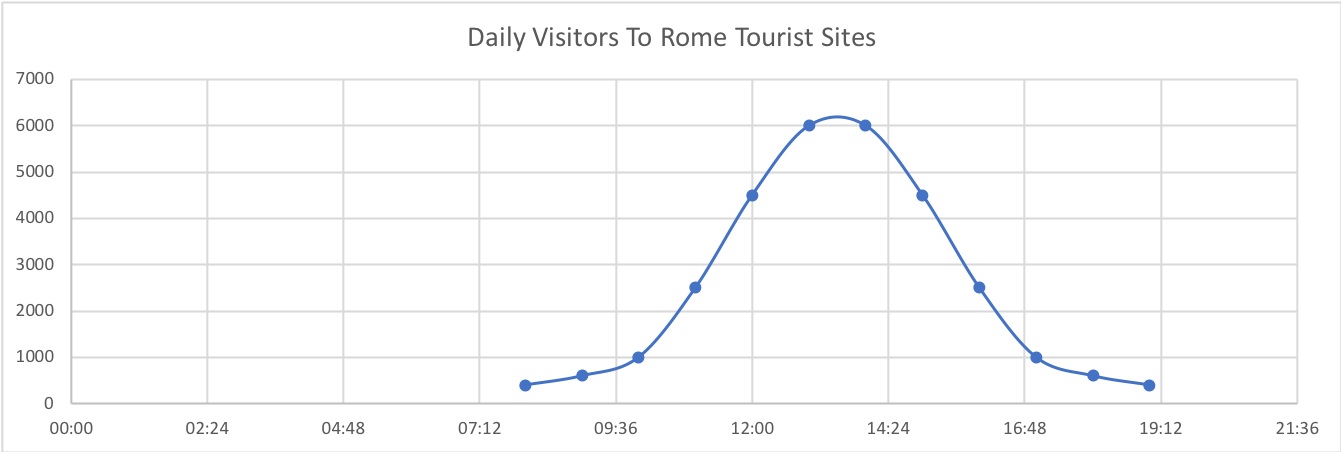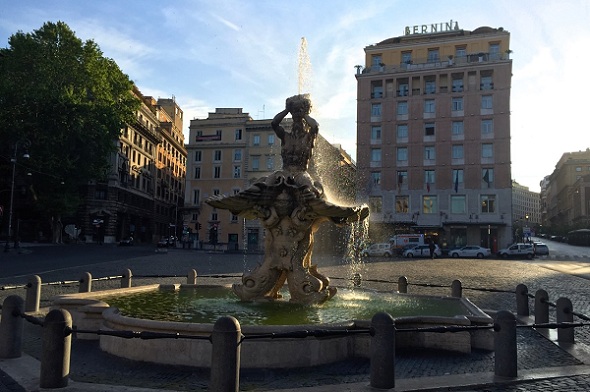Top 10 Rome Tips
Essential Trip Planning Advice for Your Roman Holiday
It seems obvious to have a top 10 Rome tips list, doesn't it?
Things to do, not to do.
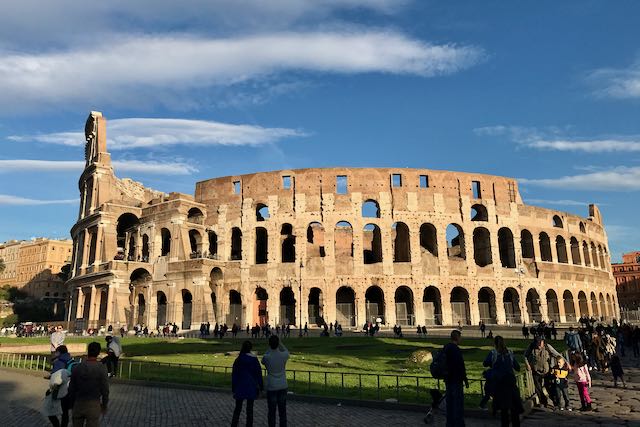 If visiting the Colosseum is a priority for your trip to Rome, make sure to plan ahead. But don't over plan!
If visiting the Colosseum is a priority for your trip to Rome, make sure to plan ahead. But don't over plan!Romewise is full of tips (you can browse the navigation menus or use the search box to find what you're looking for.)
But I realized you might just want a quick view of the most essential tips for planning your Roman holiday.
So here goes.
Top 10 Rome Tips
Plan Your Perfect Rome Trip
This assumes that visiting Rome is stressful.
It can be.
But it doesn't have to be.
This list of tips and tricks to make your Rome visit a bit smoother and less stressful is a mix of advice.
It includes my tips about packing, where to stay, how to plan your itinerary, money and where to eat.
See each tip for links to pages with more in-depth advice on that topic.
My list is fairly general and yet, if you follow it, I believe you will save yourself a lot of unnecessary grief.
1. Plan ahead
This one may seem obvious but as someone who ran a B&B in Rome for nearly 20 years, I can tell you that many more people than not tend to arrive in Rome figuring they will just work it out when they get here.
I understand this.
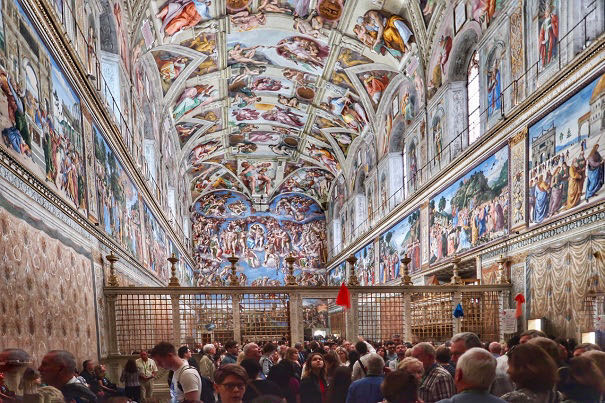 You should make a plan for visiting the Vatican Museums and the Sistine Chapel. Don't waste time showing up when they are closed, or waiting in long lines!
You should make a plan for visiting the Vatican Museums and the Sistine Chapel. Don't waste time showing up when they are closed, or waiting in long lines!We are all a bit harried in our busy lives, and sometimes taking the time to plan a trip can be exhausting.
Usually it's all we can do to book the airline tickets and maybe a hotel.
But many people come to Rome precisely because they want to see some of the must-see attractions like the Colosseum, Sistine Chapel and Trevi Fountain.
A visit to Rome can be a once in a lifetime thing, or at least, something you may not get to do again very soon.
You will want to make the most of it.
So my first Rome tip for you is to plan ahead for some of the major sites and anything that is important to you.
Find out what you need to book in advance, and how long in advance you need to book it.
Now, more than ever, you will need to book most things ahead.
The Colosseum is one of many Rome attractions that sells out.
So you will want to book your Colosseum tickets, as well as tickets to the Vatican, in advance.
Things you can and should book 1-2 weeks before you come, include the Vatican Museums, the Galleria Borghese (hard to get into in high season, especially last minute), the Domus Aurea (only open Sat/Sun), the Papal Audience, and the Mausoleum of Augustus.
There are a couple things you should book long in advance if they are important to you: Palazzo Farnese (the French Embassy and a real jewel), Palazzo Colonna (open only one day a week), Colosseum Underground or Colosseum night visits, and Saint Peter’s Tomb underneath Saint Peter’s Basilica (an archeological visit.)
These all have very limited spots available.
Plan for at least 1-2 months lead time for each.
Jump start your trip to Rome with a free ebook 😀
Sign-up to our free newsletter and receive our Quick Start Guide to Rome ebook which share's everything you need to know to plan the perfect trip to the Eternal City 🙌
2. Don’t over-plan your visit
So despite what I just said above, try not to over-plan.
Many visitors to Rome, especially if on a short break, tend to want to pack it all in and get to the must-see sights.
I understand this too.
Number 2 Rome tip is to try to avoid this temptation and plan for just one or two major things that are really important to you, like visiting the inside of the Colosseum, and/or seeing the Sistine Chapel.
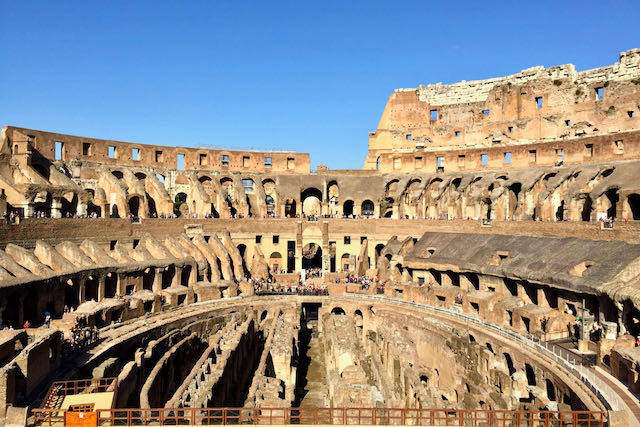 Plan for the most important things, like seeing the inside of the Colosseum (and maybe the arena floor), but don't over-plan. Leave space for some downtime.
Plan for the most important things, like seeing the inside of the Colosseum (and maybe the arena floor), but don't over-plan. Leave space for some downtime.Then, try to get to the other things on your list, but allow some time for resting, relaxing, strolling, shopping, eating, and just enjoying.
You also need to consider the time it takes to get to and from places, whether on foot or by taxi/bus/metro.
Visit my pages about how to visit Rome in 1 day, how to visit Rome in 3 days, and how to spend a week in Rome.
You'll find I left some downtime in there!
3. Bring cloths for layering
We are blessed with fairly mild weather in Rome.
But no matter the season, layering is a good idea.
- In spring and fall, it can be really warm during the day but cool down considerably at night.
- Even in the dead of winter, you'd be surprised how warm you can get walking around and sight-seeing during the day, when the sun is overhead.
- And in summer, you will want to have something to cover your shoulders and knees for visiting churches. This includes (especially) the Vatican, Sistine Chapel, and catacombs.
Which brings me to the scarf.
Always have a scarf handy, even in summer.
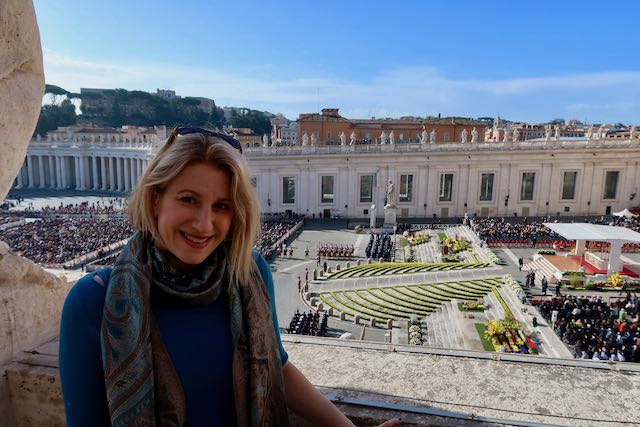 Layer! Here's the whole enchilada for you - I have a summery dress on, and a top over it. The top covers my shoulders (since I am at the Vatican), and keeps me warm (since it's Easter, and a little chilly). And, I have my handy scarf, which dresses me up for a Vatican mass, and also keeps me warm.
Layer! Here's the whole enchilada for you - I have a summery dress on, and a top over it. The top covers my shoulders (since I am at the Vatican), and keeps me warm (since it's Easter, and a little chilly). And, I have my handy scarf, which dresses me up for a Vatican mass, and also keeps me warm.Click here to find out what to pack for Rome (and, check the top of every page for my specific month-pages for Rome, to find out what to pack for every month).
4. Wear only comfortable shoes and plan on walking
You will do more walking in Rome than you think.
It's also much harder on the feet and legs here than it is in other Italian cities.
We have cobblestones in a lot of Rome, and they are made of basalt, a very unforgiving stone that will wreak havoc on your body.
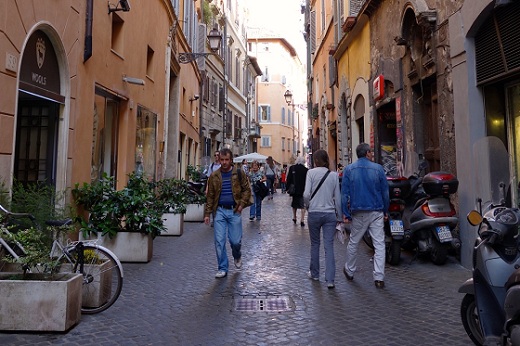 Plan to walk a lot. And wear the most comfortable shoes you have. Rome has lots of cobblestone streets that will wreak havoc on your legs and feet.
Plan to walk a lot. And wear the most comfortable shoes you have. Rome has lots of cobblestone streets that will wreak havoc on your legs and feet.Inside of sites like the Colosseum, Palatine Hill, Roman Forum, and Vatican, you will walk a LOT.
And you won't realize it because you will be excited, taking pictures, and enjoying what you are seeing.
But when you are done, your feet will thank you if you listen to me.
My number 4 Rome tip is to come in the most comfortable shoes you have.
Don't bring shoes you have to break in.
Avoid flimsy flip flops. Trust me on this.
5. Cash is your friend
My number 5 Rome tip is all about cash - how to get it while in Rome, and why you need it.
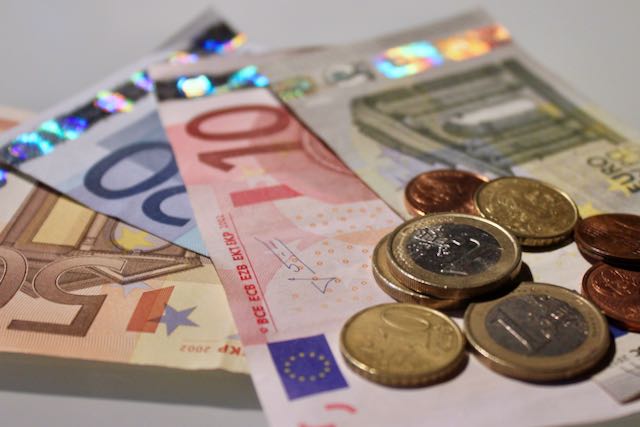 Plan to use more cash than you are used to, but don't bring it with you. Get money out from ATMs as you need it.
Plan to use more cash than you are used to, but don't bring it with you. Get money out from ATMs as you need it.Don't bring a lot of cash with you.
The most cost-effective and convenient way to have Euros while travelling in Rome (and other parts of Europe) is to use your ATM card.
Find out with your bank before you leave home what the terms are and what your daily limit is, and make sure you know your pin.
On the other hand, don't walk around Rome with tons of cash.
Just enough for each day, and take out more cash if you need it.
(And consider thwarting pickpockets with this great theft-proof cross-body bag, and using an RFID blocking travel wallet or pouch to prevent identity and credit card theft.)
Prepare yourself to pay for cash a lot more than you are used to.
Large hotels, major brand shops, and most restaurants take credit cards.
But smaller shops and family-run restaurants either might not accept credit cards, or, will often have a credit card machine that is "out of order".
Ahem.
Visit my page about Money in Rome for lots more advice on this subject.
6. To eat well in Rome: avoid dining in a major tourist piazza
There are plenty of places to eat while sitting on a beautiful square or piazza in Rome, and take in the views.
Unfortunately, at most of these places, you are likely not to eat that well.
And, you'll probably over-pay for what you get.
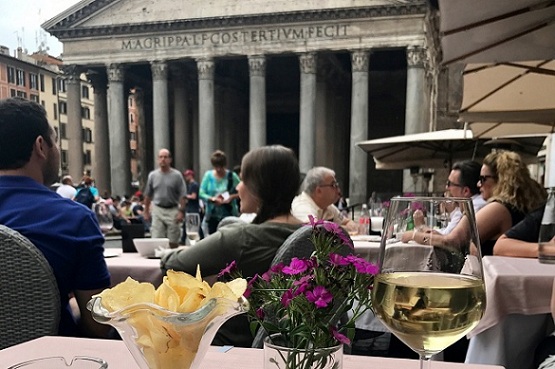 Avoid eating a meal while sitting on a touristic piazza. I'm all for having a drink and enjoying the view on a plaza like this one, facing the Pantheon. Eating a meal is a different matter.
Avoid eating a meal while sitting on a touristic piazza. I'm all for having a drink and enjoying the view on a plaza like this one, facing the Pantheon. Eating a meal is a different matter.Also avoid any restaurant where someone is gesturing for you to come in.
If the food is good, they shouldn’t need to lure you in.
Avoid using TripAdvisor as a way to judge restaurants.
How do you know that you have the same taste or standards as the person whose review you are reading?
My number 6 Rome tip is to look for restaurants on smaller side streets, ask taxi drivers and other locals where they like to eat, and check food blogs by good local writers.
7. Don't pay for water
Especially in hot months, you will be tempted to buy water the minute you feel over-heated and dehydrated.
And usually this involves buying from a street vendor or vending truck at a jacked up cost (3-4€ per little bottle).
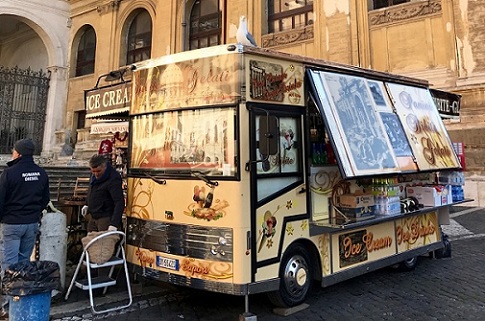 Don't (over) pay for water from street vendors. Rome has lots of fresh, clean drinking water all around the city. It's delicious, it's cold, and it's free!
Don't (over) pay for water from street vendors. Rome has lots of fresh, clean drinking water all around the city. It's delicious, it's cold, and it's free!Number 7 of my Top 10 Rome Tips is to drink Rome's free water, which comes out of little fountains and spouts all over Rome, called nasoni.
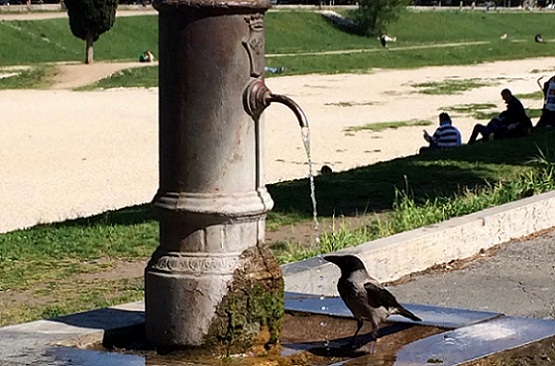 Drink Rome's delicious cold water for free, from the nasoni all around the city.
Drink Rome's delicious cold water for free, from the nasoni all around the city.This water comes from the mountains outside Rome, and it comes over those Roman aqueducts into Rome.
It's cold, it's clean, and it's free.
Here's how to drink from Rome's nasoni:
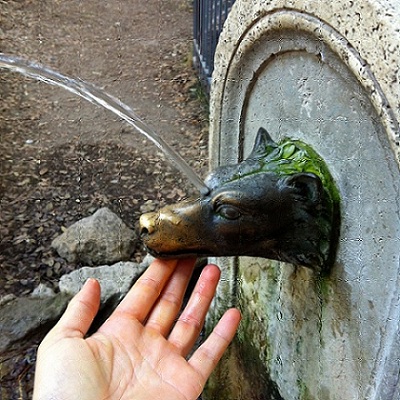
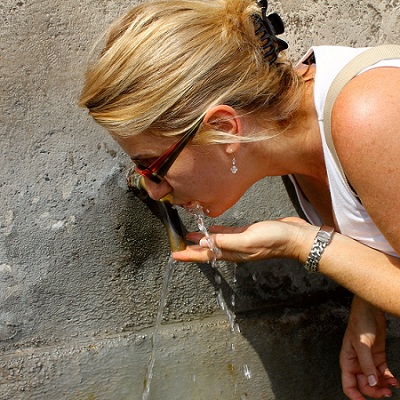
Bonus tip!
Bring along this collapsible, ecologically friendly re-usable water bottle.
8. Don't over-tip
Italy does not have a tipping culture.
For most services, you don't need to tip at all.
However, nobody will mind if you tip. On the contrary.
Some waiters are even coming to expect a handsome tip, especially from Anglo-Saxon tourists whose cultures include tipping as a way to compensate workers.
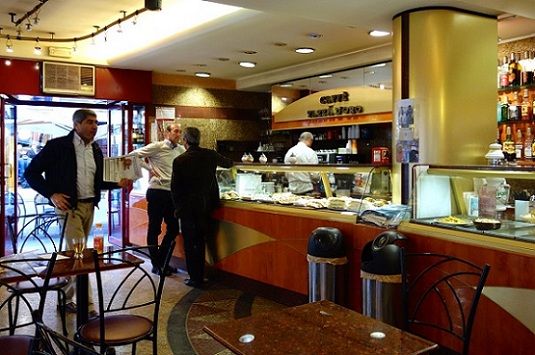 Don't (over) tip. It's just not part of the economic culture in Italy. At a bar (café), you can leave a 10-20 cent tip when you place your order with the bartender, if you want. Or not.
Don't (over) tip. It's just not part of the economic culture in Italy. At a bar (café), you can leave a 10-20 cent tip when you place your order with the bartender, if you want. Or not.If you want to tip, here are some basic rules:
- At the bar (café), pay first at the cash register, bring the receipt to the barman, and lay it down on the counter with 10-20 cents, then ask for your order.
- When taking a taxi, 0 tip is expected. I always round up to the nearest Euro, and the driver always thanks me.
- On the other hand, if you hire a private car service, you can tip if the driver helps you with your bags. 5€ for every 2 people is sufficient.
- Likewise if you hire a private tour guide, and are happy with them, you can leave a tip on top of their fee. Or not. The amount depends on the length of the tour and number of people in your group. It's really up to you.
- At a sit-down restaurant, you don't have to tip. But if you want to, you can tip 1€ per person, or maximum 2€ per person if you want to be generous. A 20% tip is overly generous.
If you are wondering why there is no tipping, it's because in Italy, waiters, bartenders, and others in any service industry make a full salary, with health benefits, sick pay, yearly bonus, and a month paid vacation.
9. Avoid the crowds by going early or late
Many of Rome's most popular sites like the Trevi Fountain, Colosseum and Vatican, have crowds nearly all year.
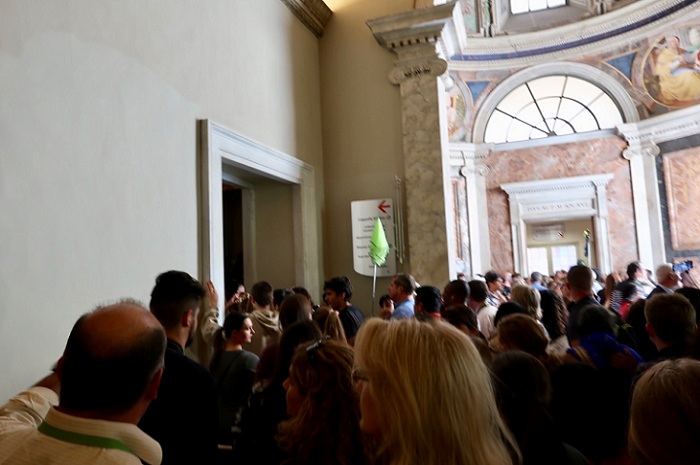 Avoid these crazy crowds at the Vatican Museums by going super early or even better, in the late afternoon or evening (when available.)
Avoid these crazy crowds at the Vatican Museums by going super early or even better, in the late afternoon or evening (when available.)If you are here in a busy season (which lately seems to include every month except for mid-January through mid-February, especially around holidays like Easter and Christmas), you can avoid some crowds by coming first thing before or at opening, or, at the end of the day close to closing.
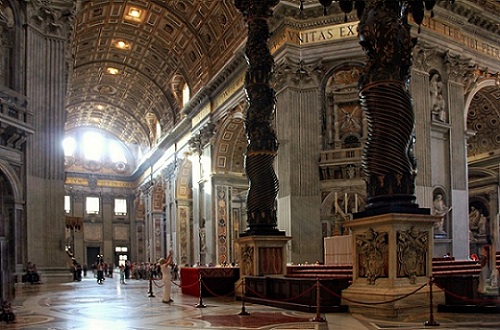 I think visiting Saint Peter's basilica right when they open at 7 AM is just magical. The light is wonderful and there are never any lines or crowds at this hour.
I think visiting Saint Peter's basilica right when they open at 7 AM is just magical. The light is wonderful and there are never any lines or crowds at this hour.Saint Peter's Basilica opens at 7am, and it's just beautiful.
Same with the Spanish Steps.
But between about 10am - midnight, they will be mobbed.
Year-round.
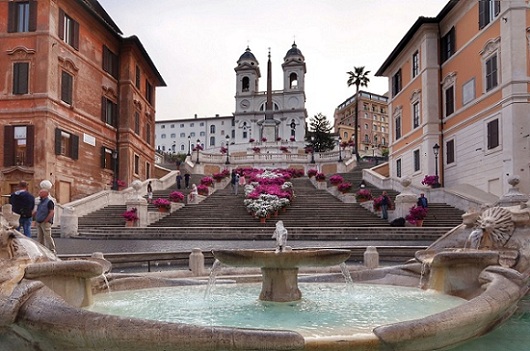 If you want to see the Spanish Steps like this, with no crowds, you have to come before 8 am.
If you want to see the Spanish Steps like this, with no crowds, you have to come before 8 am.It's only logical that the crowds at Rome's sites will follow a bell curve - there will be hardly anyone there early in the morning.
Then, the crowds will grow through the morning and peak around the middle of the day.
After around 2-3pm, the crowds slowly get smaller, and there will be very few people by the end of the day.
Many people think it's a great idea to visit the Vatican Museums early, to "beat the crowds".
But it's pretty crowded in the morning.
So if you want to go to the Vatican Museums early, just plan, and book ahead (see tip number 1 above!)
Bonus!
If you visit Rome from April - October, you can visit the Vatican Museums on Friday or Saturday night, when it's considerably less crowded than during the day.
Bottom line - it's always a good idea to visit sites before or close to their opening times, or close to or after closing.
10. Stay in or near the historic center
My number ten Rome tip is to stay in or at least near the historic center.
There are plenty of choices, from apartment rental, to B&B, to 5-star hotel, in just about every Rome neighborhood.
Click here to visit my neighborhood guide to Rome, complete with map.
Here are the benefits of staying in the center of Rome:
- You will minimize the time you spend taking public transportation in and out of the city to your accommodation.
- If you shop, you can drop things off and head back out.
- If you get tired, you can easily go take a nap or shower before going back out again
- Finally, it allows you to easily double back and see something you might want to see twice, like the Pantheon or Trevi Fountain.
